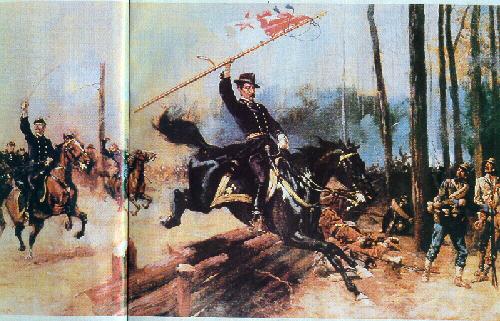
| A Taste of
NORTHERN STEEL |
THE EVOLUTION OF
|

"Colonel Minty now ordered the ‘Seventh’ (Pennsylvania) to charge. Five hundred sabres leaped from their scabbards. Five hundred horses chafed the bit, and sprang forward at the touch of the spur. The charging column moved down upon the enemy like an avalanche. The enemy’s column was also moving forward to re-enforce their picket line; but when they saw the forest of gleaming swords, they broke and ran. The ‘Seventh’ was close upon their heels, helping them on by pelting them with the sword." (Attack by Colonel R.H.G. Minty’s Brigade at Rover, Tennessee, March 4, 1863) 2
"...we came up to the enemys fortifications and entrenchments (3 miles west of Shelbyville, Tennessee). Our Regt being in advance was ordered or rather Four Companies being ordered to dismount and fight on foot whilst eight companies were held as a reserve to watch any movement the enemy might attempt to make. As the 4 companies were advancing we found that the enemy were trying to charge the artillery. Lt Col Sipes and Major Seibert on seeing this ordered a charge and in went our boys over entrenchments, fortifications and completely routed the enemy." (Thomas Rickert, 7th Pennsylvania Cavalry, June 27, 1863) 3
"I deployed the column in line...drove them again. West of Upperville the 8th Illinois, 3rd Indiana and 12th Illinios came on rapidly at a gallop, formed in line, charged upon the enemy’s five guns amid a shower of shells, shrapnel and case shot, drove the rebel gunners from their pieces, when the enemy’s cavalry, seven regiments strong, emerged from the woods, and a hand to hand conflict ensued, the enemy out numbering us three to one. We retired a short distance behind a stone wall and maintained our position, repulsing the repeated charges of the enemy by well directed carbine and pistol firing." (Colonel William Gamble, Upperville, VA, June 21, 1863)4
Stephen Z. Starr's The Union Cavalry in the Civil War (1979) explored the development of the Federal cavalry on a comprehensive scale.5 He challenged ‘the common belief that the American Horsemen were merely mounted infantry’6, simply using their horses as transportation to the battlefield, and suggested that they had evolved into something more complex - troops who did most of their fighting dismounted, but who never ceased to consider themselves as cavalry. The apex, he felt, of Federal cavalry development during the war was Major General Philip Sheridan’s Valley campaign and Major General James Wilson’s 1865 invasion of Alabama. These campaigns threw masses of cavalry into the heart of the Confederacy, where they operated as integral strike forces. While Sheridan’s cavalry cooperated closely with the Federal infantry, Wilson actually had an entirely independent cavalry army of over 12000 men. Starr, however, while recognizing that the Federal Cavalry had significantly changed from the pre-war army, seemed uncertain whether this represented an evolution of mounted troops specific to the challenges of the Civil War or if it was simply part of the longer process of the development of what was essentially the mounted infantry of the Indian Wars. He recognized that the Federals saw themselves as cavalry, but was unclear if the ideology of the mounted sabre charge was just a remnant of earlier European tactics and vision, soon to be discarded, or an integral part of their arsenal. 7
The Civil War demanded that the Federal cavalryman deal with a foe similar to himself, generally in difficult terrain, whose mounted troops initially were often better trained in fighting and riding than he was. The tactics of their opponents ranged from the more traditional cavalry actions of a Jeb Stuart, to the unconventional strategies of Nathan Bedford Forrest, to the hit and run attacks of partisans. Additionally, not only were mounted troops to be faced, but infantry and artillery, in larger numbers and with better weapons than in earlier wars. The evidence, I believe, clearly shows that the Federal cavalryman responded to these challanges by combining European cavalry tactics with dismounted tactics developed in the American West to create a flexible responsive strategy. This allowed them to use either or both types of combat to effectively control their foes. It took much of the war, but far from their evolution simply being a step to some form of post war mounted infantry, the Federal cavalryman evolved into a true dragoon specifically suited to fight the Confederate foe. Not simply a remnant of an earlier age, the sabre charge was an integral part of the cavalryman’s arsenal to be used in conjunction with carbine fighting. "Sheridan recognized that rapid fire breechloading arms gave the dismounted cavalry tremendous defensive power while at the same time preserving its mounted offensive power - charges with the sabre. It was not just mounted infantry but it was the combination of these two features that made it unique." What the Federals had developed was a better kind of dragoon, a mounted soldier whose firepower gave him some of the striking power of an infantryman on the ground and allowed him to be a real cavalryman on horseback. This evolution occured in both the Eastern and Western theatres, as exemplified by the cavalry actions that opened the battles of Gettysburg and Chickamauga. In both cases, the firepower of dismounted cavalrymen plus the mounted charge delayed large formations of regular Confederate infantry, leading to the eventual realization by the Federal command that these tactics allowed the cavalry to do not only the traditional tasks associated with cavalry attached to infantry, but also to become an independent striking force.
When the Civil War ended and the volunteers went
home, the Regulars retained these lessons, but the situation facing the
army in the West after the war made it clear that this kind of dragoon
was no longer appropriate and the tactical emphasis pragmatically shifted
to mounted infantry. Sabres and sabre charges were pretty much abandoned
after the Civil War, not because that was the culmination of a trend towards
mounted infantry that had begun during that war, but because what the mounted
arm had to do had changed and the sabre was no longer practical.
The Creation of Mounted Trops
in the United States
By the nineteenth century, war in Europe had evolved into an affair of close-order infantry armed with muskets, field artillery, and several types of cavalry. There were essentially three types of mounted troops - heavy cavalry, light cavalry, and Dragoons. They were called upon to accomplish a variety of tasks, ranging from reconaissance to charging infantry.
The heavy cavalry were the shock troops. Composed of big men on powerful horses, usually wearing metal helmets and body armor, their prime tactical function was the massed charge against enemy infantry, a tactic that worked well in the open plains of Europe against the weaponry of the day. Their great size, confidence, and reputation gave them a great psychological edge. The grandure of the massed shock charge seized the imagination of European military minds and left its’ imprint for most of the century, even as advances in weaponry made such charges more and more perilous. The heavy cavalry was Europe’s ‘star’ cavalry. 8
Heavy cavalry was expensive to maintain, thus most European countries utilized a variety of light cavalry. More lightly armed and dressed in colorful uniforms, they were expected to be flexible, able to scout and man outposts, but also have the ability to support the infantry during battle with well timed charges. The light cavalry provided close support to the infantry and pursuit of a routed enemy, while the heavy cavalry was expected to be the force which broke the enemy. 9
Finally, there was the dragoon. He was a hybrid between the light cavalry and the infantryman. Mounted and lightly armed, he could act as the scout or screener, and, in theory, could dismount and fight as light infantry. In Napoleonic times, many dragoons acted more as medium cavalry - expected to do all the tasks of cavalry, including charge as light cavalry. Others acted solely as infantry.10 Although the role of the European dragoon, the least prestigious of the cavalry, was extremely variable in practice, it was precisely the dragoon that would furnish the model for the best type of Civil War cavalry. The development of the Federal dragoon, though, would go beyond the European model, tempered by American realities and new firepower.
All European cavalry were armed with swords or sabres. In addition, they were also burdened with a variety of firearms, often two pistols and a carbine. Napoleon also armed a few regiments with lances, beginning a revival of that weapon which was briefly reflected in the American Civil War by the 6th Pennsylvania (Rush’s Lancers). 11
Although the functions of the various types of cavalry were supposed to be somewhat different, in practice they overlapped. In short, they were:
2) Screening: covering and concealing the movements of your own army from the enemy’s reconaissance attempts.
3) Covering the flanks and rear of your army in battle and threatening those of your enemy.
4) Shock charges against the enemy to break them, to produce a rout, or, when your own army is withdrawing, to delay the pursuit.
5) Picketing, orderly, and provost duty.
6) Long distance raids designed to attack the supply lines of the enemy. These sort of raids became frequently used in the American Civil War.12
The next fifteen years did little to clarify or develop cavalry doctrine. In the Mexican war, considered the cradle for many fine Civil War officers, mounted troops were seldom used, thus providing little in the way of useful experience.16 While the 1850’s saw the introduction of mounted tactics in the curriculum of West Point (1853) and produced two new regiments, designated as the 1st and 2nd Cavalry (1855), their service was similar to that of the dragoons, being spread over the West in company and squad formations. There had, in fact, never been any kind of concensus as to what type of mounted troops the American force should be. They had been directed to be cavalry or dragoons, but in practice tended to be poorly armed and badly used mounted infantymen.
The use of Poinsett’s did, however, introduce the European cavalry tradition to the officer class. Although their western experience had demonstrated otherwise, many officers felt as George McClellan did, that "the strength of cavalry is in the spurs and sabre." 17 Many of the future commanders of the Union cavalry would come out of these regiments with this ideology. Operating in small formations against Native Americans, however, tended to favor skirmish warfare, not the massed sabre charge. Fortunately, in addition to absorbing the ideology of the sabre charge, most seem to have also retained the lessons learned from plains warfare. Unfortunately, no American cavalry strategist arose to systematize their experience nor think how it might apply against a foe armed and organized as themselves. Thus as the Civil War approached, the men who were to lead the cavalry were left with a muddled mixture of lessons from the West combined with European cavalry ideas and tactics. "The mixed concepts of the cavalryman as a sabre-swinging horseman and as a Mounted Infantryman, products of European influence and Indian warfare experience, were carried into the Cavalry camps of both Union and Confederate armies." But this experience, muddled as it might be, would form the basis for the development of the Federal cavalryman/dragoon.
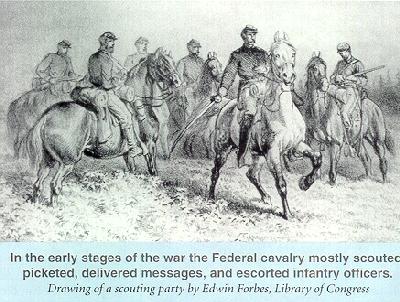
When Fort Sumter was fired upon in April of 1861, the United States had just five mounted regiments scattered at posts all over the West. Many of their officers had, or would shortly, resign to take commissions in the new Southern Confederacy. Joined by a sixth regiment in May, they were renumbered by date of organization as the 1st to 6th US cavalry, usually referred to as the ‘Regulars’. This, at least, was an attempt to recognize that whatever their previous designation, all the U.S. mounted troops had developed on the same lines, dictated to some extent by the nature of the West and their Native American opponents. But, considering the scope of the war that had just erupted, it was nearly like having no cavalry at all. That was fine with Brevet Lieutenant General Winfield Scott, General-In-Chief of the Federal forces, who saw no use for mounted troops in the coming war. Virginia, he felt, was too full of uneven ground, woods, and fences to allow European cavalry tactics. Besides, he reasoned, the war was undoubtably going to be short, cavalry was expensive, took years to train, and the government, having never stockpiled any cavalry equipment, had nothing to give them anyway. Volunteer regiments were only being raised for 90 days, far too short to train cavalry, so Scott saw no reason to authorize any volunteer mounted units.
After the rout at First Manassas, President Lincoln overruled Scott’s decision and by December 1, 1861, there were fifty cavalry regiments being raised. Scott’s influence, though, had a lasting effect on the attitude of the War Department, supply of equipment, and use of the cavalry for the first part of the war, giving the South a real advantage as the North struggled to equip and train troopers. 18
The problems which faced the Lincoln government trying to create the Federal cavalry were enormous and no discussion of their solutions can make any sense if we do not understand their nature. There are three basic questions that face any government trying to establish a mounted force. The first rests on the strategic and philosopic level. What will the mission of this mounted force be? What do we want it to perform for the army? Shock attacks? Raids? Picket duty? Having answered that question, the second question is tactical. Given the mission(s), what type(s) of troops do we need, how do we utilize them, and with what do we arm them? Do we want heavy or light cavalry, mounted infantry, or some combination (dragoon)? What tactics should they use and what weapons? Should they be used en masse or in small detachments, mounted or dismounted, in united commands or under the control of infantry and artillery officers? Answering this question must take into account the parameters that limit or support cavalry activity. If, for example, the woods of eastern Virginia are not conducive to much mounted fighting, then what type of cavalry and what type of fighting will work in such areas to accomplish a mission, for example, such as covering the flanks or attacking the enemy’s flank? Finally, the third set of problems are logistical. Given the mission and the proposed methodology for accomplishing it, how do we now actually go about creating this mounted force. Where do we get the soldiers, obtain sufficient equipment, and go about training and getting them to the theater of war.
While the emphasis of this article is to examine
the development of tactics and mission, all three of these sets of problems
are interrelated and impact the others. If the definition of mission changes
or evolves, so too must the tactics employed to accomplish it, and perhaps
the logistics as well. If, for example, cavalry will mostly be expected
to make long mounted raids, then the organization of the troops may change
as well as the weapons it carries. On the other hand, if horses are simply
not available, this type of mission cannot be accomplished, no matter how
well trained and equiped the troops are. What should be borne in mind is
that the evolution of the Federal cavalry is a process and as such, involves
change in all of these areas as the ideas about the function of the mounted
troops changed.
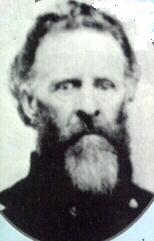
It took well over a year for the Federal cavalry
to be of much use and while part of the problem was logistical in nature
(supplying and training raw recruits and horses), a significant part was
simply the unpreparedness of the War Department on the philosophical and
tactical level. There was, in fact, no agreement in the Department or its
officers as to how cavalry should be used. This is hardly surprising considering
they were using a tactical manual that embraced a Napoleonic era tradition
of fighting, had twenty-five years of practical experience which contradicted
it, plus Winfield Scott’s reluctance to raise any cavalry at all. When
the war broke out, the Colonel of the 1st Dragoons, Phillip St. George
Cooke, was asked to prepare a new manual, but it was out of date almost
as soon as it was written since it was based on the assumption that the
United States would never field cavalry units larger than a brigade.
Poinsett’s, in fact, continued to be used. 19
In 1861, the government was faced with raising masses of volunteer cavalry who would face a foe similarly organized and equipped. Incredibly, no one at the War Department seems to have sat down and thought just how applicable the theory they had been teaching was to the special conditions of terrain and modern weaponry of the Civil War. Nor even to consider how cavalry ought to be used in conjunction with the other two arms of the service in such a war. What should cavalry do? Should it just support the infantry and artillery or would it have the capability of fulfilling an independent strategic role? Clearly this was no longer the Western Plains and the mission of cavalry should have changed accordingly. It did so, but it was more of an unconscious evolution - commanders were faced with conditions that were adverse to what they may have learned and they had to innovate or get beaten. The Federals in both the East and West got beaten quite a bit in the first two years of the war, but they learned. By Spring of 1863, the Union cavalry had not only the skills but the strategies to not only hold its own, but to become superior to the Confederates. In the process, they developed a tactical sense of how to accomplish their mission, a process that incorporated the long taught but little used sabre charge with the dismounted carbine tactics learned in the forests and plains of North America. It would be nice if the evolution of anything was a nice simple curve, consistent in development and smooth in its course. Unfortunately, that is rarely the case and what has been said about the Union cavalry above is distilled from the experiences of a great many regiments operating in the Eastern and Western theaters of war. Not every regiment developed into excellent cavalry/dragoons. Some were poorly led and organized while others were never heavily involved in combat. Many, though, were in the thick of things and are representative of how the cavalry evolved. Amongst these were Colonel William Gamble’s Brigade, which included the 8th Illinois, in Brigadier General John Buford’s Division, and Colonel Robert H.G. Minty’s Brigade, which included the 7th Pennsylvania.
Recruitment
Before the process of learning could begin, however, the North had to raise cavalry. Thousands of recruits answered the call, some seduced by the romantic reputation of the horse soldier, while others preferred riding to marching. It was easy enough to sign them up but getting them out on the field as an effective force would be another matter. Conventional wisdom held that it took two years to train either a cavalryman or his horse. Many of the new recruits, especially in the East, had not ridden horses or fired a gun before, much less tried a sabre charge! The horses, too, were green and many unfit, sold by unscrupulous contractors to the government. Troopers needed to be taught how to take care of themselves, as well as their horses and equipment. This, of course, assumed that they had equipment. The government had a shortage of all kinds of horse equippage, as well as decent arms, that lasted well into 1862.20 Units were equipped with all sorts of things, much of it bad, and in any case mixed, so that a whole company might not have the same arm - a great problem in terms of supplying ammunition in the field. The Regular cavalry did not provide instructors to the volunteers, so there were few men, officers or enlisted, who had any experience. Typical of the newly minted officers was John Farnsworth, Colonel of the 8th Illinois Cavalry, a Congressman from St. Charles, Illinois and friend of President Lincoln. Authorized by Lincoln to raise a regiment of cavalry, he commanded it not because of experience (he had none) but because he was responsible for recruiting it.
The new cavalrymen were sent to camps of instruction to learn how to ride and drill. It is clear from the records that the volunteers expected to be cavalrymen in the classic Napoleonic tradition and hours were spent on sabre drill. Fortuntately they also learned dismounted drill for when they started to fight the enemy cavalry, they found they needed both. This was especially true in the West where Colonel John Hunt Morgan and General Nathan Bedford Forest used their Confederates as mounted infantry rather than cavalry. 21
Often unarmed and just beginning their training,
regiments were quickly sent to the seats of war. As one veteran observed
after the war, "It seems as if each recruit for the cavalry thought the
especial requirement for that branch of the service was that he could neither
ride, saddle, nor groom a horse."22 This would
soon change as the men began to drill regularly. Private Reuben T. Prentice
of the 8th Illinois wrote home that "we have been drilling on foot and
now drill five hours a day on horse back."23
The horses were also green and that occasionally provided great excitment
as noted in Private Silas Wesson’s diary of the same regiment. "We are
drilling on horseback now. Have lots of fun. When we draw sabres the horses
run away and the Col. swears harder than ever."24
Clearly, there was much for the men to learn. Fortunately for the 8th Illinois,
they had a former Sergeant Major from the 1st Dragoons, William Gamble,
who was preparing them in both mounted and dismounted tactics.
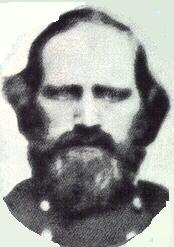
To do any kind of fighting, however, would require
arms and these were a long time in coming. The volunteer cavalry received
the same type of arms that the regular mounted troops had always received
- carbine, pistol, and sabre - but the country had a great shortage of
arms and troopers had to take what was available. The 8th Illinois was
issued pistols, which turned out to be pretty inferior, but by Christmas
of 1861, they had been replaced with the excellent Colt’s revolvers. 25
Private Prentice reported from Alexandria that "we have all
got to be Sharp Shooters (T)he whole Regt we all now are armed with Sharps
Rifle and Colts Revolver and Saber which makes quite a load. ...we are
the only Cavalry in this section that are armed with rifles (W)e have now
got our full equipment of armes and are ready to give Secesh fits." 26
The experience of the 7th Pennsylvania cavalry mirrors the 8th Illinois in many ways. As part of Robert Horatio George Minty’s Brigade, it became known throughout the West as an excellent regiment in an excellent brigade. "There were few, if any, better cavalry brigades in the entire Union army than this one. Its men were tough and high-spirited, skilled riders, and among the first to be armed with repeating rifles. Moreover, ... it ... could and did make successful sabre charges - an ability that gained it the nickname of ‘The Sabre Brigade."27 Such brigades, however, had to be created. At the beginning, the Westerners were as green as the Easterners, but their problems were compounded by the vast size of the Western theatre. In general, the supply problems were greater and the equipment poorer the further you got from Washington.
In December 1861, the 7th Pennsylvania was sent west to Louisville. Before January was out, they were ordered to march south to join Major General Don Carlos Buell’s Army of the Ohio. They were initially provided with poor Belgian muskets, which fortunately for them, were condemned as useless and replaced by Smith and Burnside carbines in the Winter of 1862.
While McClellan and the Army of the Potomac sat and drilled about Washington, the western armies of Grant and Buell determined to take the offensive. And so, on January 26, the 7th Pennsylvania, some one thousand men and officers, left its camps in Jeffersonville, Indiana, crossed the Ohio back to Louisville, and proceeded south towards Bardstown.
The work of packing had to be done in a hurry. Most of our company were excellent horsemen, accustomed to the saddle; but how to pack bed and board, household goods and three days provender on horseback, was a mystery yet to be solved. To leave anything behind was not once thought of; the castaway clothing of other regiments had to be gathered and lugged, that nothing be lost.
Two woollen blankets and a coverlet brought from home were hurriedly rolled into a bundle two feet long and a foot thick, which was strapped on the saddle behind; the rubber dolman overcoat, carpet sack with several suits of underclothing, shaving-tools, shoe-brush and blacking, and perhaps a sheep-skin, had to be packed in front. The side-pockets, or saddle-bags, were filled with crackers and forty rounds of ammunition.
The dragoon then girded himself with a heavy cavalry sword; on one shoulder hung a monstrous shooting-iron (soon replaced by the carbine), and on the other a haversack holding three days’ rations. Thus equipped the horses were led into line, each with a nose-bag dangling on his neck containing a feed of oats, and a weight of one hundred and fifty pounds on his back. The command is given. "Attention: Prepare to mount: MOUNT"
Each trooper was expected to obey the command with his accustomed agility. The scrambling to get into the saddle was highly amusing to a disinterested spectator. Some sat astride the stern of the ship, but how to get over the rear bundle was the difficulty. Short-legged men had to lead their horses to the nearest fence, and from the top rail drop down amidships. When once mounted, it was only a question of time as to how we should dismount. The inconvenience and discomfort arising from so extensive a barricade in front and rear, was compensated in part by the sense of security one felt in the presence of an enemy with small shot. (They crossed the river and the command given to "close up"). The first company that crossed the river was a mile in advance, and it was necessary to make a cavalry charge to overtake them. As soon as the horses began to gallop, the rigging of the ship and the passenger on the upper deck began to slide backward, notwithstanding the pilot held on to rein and mane for dear life. The sight was indeed ludicrous to the multitudes of spectators lining the streets on either side...
Now and then a saddle would turn earthward toward the centre of gravity, leaving the rider and his bundles, mud-splashed, in the middle of the road...This first bloodless charge will never be forgotten by those of our boys who were under the painful necessity of casting anchor in the middle of the street for repairs, at high noon on that memorable Sunday."28
Aside from the logistic and training problems, the development of Union cavalry was further slowed by the disagreement within the army leadership as to how to use it. Early army commanders, such as McClellan, Buell, and John Fremont, did not conceive of cavalry as an independent fighting force, but rather as only having use in escort, orderly, picket, and provost duty. McClellan had written that the value of cavalry lay in its shock value, the ‘spurs and sabre’, but as Commander in Chief of the Army of the Potomac, he broke them up into small detachments. Rather than fight them as a unit where the mass charge would have had an effect, McClellan attached the cavalry in small groups to infantry brigades and divisions, thus putting the cavalry in the hands of generals without any mounted experience and little interest in the use of the arm as any kind of striking force.29 The 8th Illinois was one of ten and one-half cavalry regiments sent to the Peninsula in the Spring of 1862, none of which were ever used as integral units. While Jeb Stuart used his Confederate cavalry as a striking force, the Federal cavalry mostly scouted, picketed, delivered messages, and escorted infantry officers.
In spite of McClellan’s inability to understand what
the mission of cavalry might be, the 8th and other eastern regiments began
to get a dose of combat as ‘Little Mac’ moved slowly up the Peninsula towards
Richmond. Inevitably, when on picket duty or patrol, they ran into Confederate
infantry and cavalry. The terrain was wooded and swampy, inappropriate
for mounted action, so they often dismounted to fight with their carbines.
If nothing else, it gave them experience, if few casualties. The cavalry
was not used effectively during the Seven Days battles but they tasted
hard combat and learned a few lessons. The 8th showed that cavalry could
delay advancing infantry (Mechanicsville) in order to give their own infantry
time to deploy and they showed that they had a useful function in covering
the army’s retreat. These were good lessons that would teach the troopers
to be tough veterans, but broken up into pieces, the cavalry could not
be an effective tool. Moreover, this kind of work rapidly used up the men
and horses. In concrete terms they had accomplished little towards putting
down the rebellion, but they were no longer amateurs. 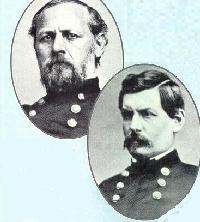 They
had learned a bit about campaigning and fighting and while not yet as good
as their Southern counterparts, they were gaining skill.
30
They
had learned a bit about campaigning and fighting and while not yet as good
as their Southern counterparts, they were gaining skill.
30
The western cavalry in 1862, like their eastern comrades, were all divided up amongst the various infantry commands, being used for escort, patrolling, scouting, and orderly duty. Grant and Buell, like McClellan, seemed to have no idea of the use of cavalry beyond these tasks. Things got so confused at one point that Buell’s Chief of Staff, referring to orders that posted portions of the 7th Pennsylvania in Nashville, Murfreesboro, Tullahoma, and Cowan, Tennessee, commented "I am unable thus far to find out where all the companies of this regiment are." Only Major General John Pope, before he went east in August, seemed to understand that cavalry could only be effective if kept together in a body. 31
Like the 8th Illinois, though, the 7th learned some important lessons in that instructive year of 1862. The regiment rarely, if ever fought together, but its battalions were sometimes united for a scout or action. Their enemy was usually detachments of cavalry under the command of John Hunt Morgan or Nathan Bedford Forrest. Unlike Confederate General Joe Wheeler, Morgan and Forrest scorned the sabre and fought with rifles and pistols. Although the Confederates had the upper hand at first, Union cavalry continued to use both sabre and firearms. Throughout 1862, the 7th and the other regiments that eventually made up Minty’s Brigade (4th US, 4th Michigan, and 3rd Indiana (battalion)) were increasingly involved in actions with the enemy that required dismounted carbine tactics and/or sabre charges. They learned that there were times a sabre charge worked and times that a carbine was the superior choice. Learning the difference eventually allowed them to gain the advantage over the Rebel cavalry.
1862, then, was a year where the Federal cavalry gained fighting skills and began to experiment with tactics. This learning process was materially aided in the East by Pope, who recognized the need to put the cavalry into larger commands under competant leaders. His actions were reinforced by Major General Joseph Hooker, who, in command of the Army of the Potomac in the Spring of 1863, created the cavalry corps and took control of the mounted arm out of the hands of infantry brigadiers.32 In the West, it was Major General William Rosecrans who saw the need for concentrating cavalry. Replacing Buell in the Fall of 1862 as the Commander of the renamed Army of the Cumberland, he recognized how the cavalry had been used up. He ordered Brigadier General David Stanley to detach the cavalry from the infantry and begin the process of refitting and concentration.33 Once concentration was achieved in both theatres of war, the cavalry became more effective. The benefits of these actions soon became apparent.
In the Fall of 1862 the 8th Illinois, still broken
into detachments, put what it had learned on the Peninsula to good use.
In the days before the battle of Antietam, for example, they were involved
in several charges with both sabre and pistol in actions against Stuart’s
cavalry. They fared pretty well, killing and capturing a number of his
cavalrymen, as well as capturing the colors of the 12th Virginia. 34
These actions were distinguished by both sabre fighting and
dismounted carbine actions. 35 One particularly
interesting action occured at Barbee’s Crossroads, Virginia, on November
5, where the brigades of Pleasonton and Averill, to whom the 8th Illinois
was now attached, met the forces of Stuart. Benjamin ‘Grimes’ Davis, Colonel
of the 8th New York, (Averill’s brigade) met a charge of the Rebel horsemen
by dismounting part of his regiment behind a stone wall. Their carbine
volleys ripped apart the Confederate column and threw it into confusion.
As the men in grey reeled back in disorder, Grimes sent in the rest of
his regiment, mounted, and drove them off the field. This was a classic
example of the new tactics being applied and illustrated how the Federal
cavalry was beginning to understand how to handle the Confederate cavalry.
As the year 1862 closed for the 8th Illinois, the skill to employ these
new tactics was becoming evident. 37 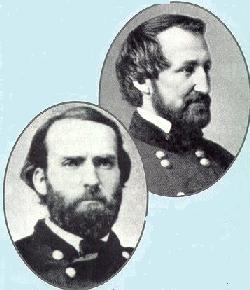
The western cavalry under Stanley and Minty showed that they too were beginning to be quite effective with these tactics. Stanley, a former dragoon, insisted that his cavalry sharpen their sabres, for the use of the sabre represented an attitude, a chip on the shoulder that he felt the Federal cavalry needed. He did not, however, ignore the firepower of the cavalry and insisted on repeating rifles for his new command. At least part of the 7th Pennsylvania had them by mid December. 38
Although no formal orders were received to create a cavalry division, Rosecrans allowed Stanley to do so de facto and the 7th now was brigaded with the 4th Michigan, 3rd and 4th Kentucky, and 3rd Indiana under the command of the 4th Michigan’s Colonel Minty. Later the Kentucky regiments would be replaced by the 4th US. Stanley had to pry the detachments of cavalry away from the infantry commands, but Rosecrans backed him up and it was not long before the cavalry units began to be reunited.
In the Spring, Stanley would recruit up the strength of that arm, but now, in December, he had to deal with Rosecrans’ move towards Murfreesboro. On the 26th, the cavalry moved out in the advance to feel out Bragg’s army and to protect the movement of its own - typical missions of the cavalry when moving with the full army. Stanley’s retrieval of the cavalry into regiments and brigades made them more effective as they moved through the countryside skirmishing with the enemy, but they were still heavily outnumbered by the Confederate cavalry. By the evening of December 30, the two armies lay near each other at Stones River, west of Murfreesboro. As the Federal army assumed its position, Minty’s Brigade skirmished with Confederate pickets and engaged in a running fight with Wheeler’s men who had captured a wagon train. Rosecrans intended a morning attack on Bragg and withdrew all his cavalry but one battalion of the 7th to the rear of the Federal right wing. Instead of posting his cavalry on his flank where they might have detected an attack by the Confederates, he posted the single battalion of the 7th as a string of videttes, not in front of the right wing but behind it to prevent straggling when the Union forces attacked the next morning. 39
The morning of December 31st, though, saw not Rosecrans but Bragg successfully attacking and with the collapse of the Federal right wing, a number of the 7th Pennsylvania were overrun, first by panicked Federals and then by Confederate infantry who took them prisoner. Stanley’s cavalry was now ordered up to try and help stem the tide of disaster. Brigidier General John Wharton’s Confederate cavalry were soon met with and driven back.
Here Minty and Stanley used a variety of dismounted tactics combined with mounted support to receive the enemy and then sabre charges to break their lines as they came forward. Stanley had not had the cavalry long, but clearly he seemed to have an idea of how to use it.
The experience of the Federal cavalry to this point suggests that the government went about creating a mounted force completely backwards. Instead of deciding on a mission first and then answering tactical questions before actually raising troops, troops were raised, equipped haphazardly, and inconsistantly trained with no real mission or tactical questions answered. Used poorly at first, new commanders arose in mid to late 1862 who pushed for a concentration of force and for better ways to use the cavalry which allowed the mounted arm’s tactical sense and mission to become more developed during the next year.
By the Spring of 1863, the men had developed into
cavalrymen (or perhaps more accurately dragoons) who now had the skills
necessary to ride, shoot, and, to a degree, wield a sabre. They also began
to get army commanders who were willing to put the cavalry back together
as regiments, brigades, and divisions, thus allowing their more efficient
use in protecting the flanks of the army and locating and developing the
enemy. 1863 also saw the beginning of the mounted raid as a Federal strategy,
especially in the East. Jeb Stuart, of course, had already introduced the
Federals to the effects of such raids and Union cavalry leaders, such as
George Stoneman, pushed the high command of the Army of the Potomac to
let the Federal cavalry carry out similar feats. These raids never really
produced any long term effect, until Wilson and Sheridan were actually
cut loose with command independence, but they added visability and a new
mission to the cavalry.
With Rosecrans’ support in the west and Hooker’s
reorganization of the cavalry into a corps in the Spring of 1863, confidence
and morale soared. The cavalry in both theaters were involved in clashes
where they gained success and proved that they had indeed learned how to
utilize the mounted and dismounted tactics that allowed them to fulfil
their various tasks. Kelly’s Ford, Brandy Station, Tullahoma, McMinnville,
and so on provided the evidence that the Federal Cavalry had come of age.
Two actions in particular, though - Buford at Gettysburg on July 1 and
Minty at Pea Vine Creek and Reed’s Bridge (Chickamauga) on September 18
- showed not only how the cavalry had mastered tactics, but how they could
be useful in protecting their army and delaying the opponent’s infantry.
Already effective dragoons, this, plus the mounted raid, provided evidence
that the cavalry could act not just as scouts and guards, but as an integral
strike force for the army.


Buford was another old Regular, serving between the Mexican and Civil Wars in both the 1st and 2nd Dragoons. Having seen a great deal of the West and of Indian fighting, Buford had become quite practical in his ideas of tactics. Wilson was fond of saying that "Buford entertained no prejudices in favor of fighting with the saber, or against fighting dismounted when the circumstances of the case called for or seemed to justify it." He was one of those gifted leaders who were arising to take advantage of the skills that the Federal cavalryman had developed over the preceeding two years. Rescued from a desk job in Washington in the summer of 1862 by Pope, he quickly established a reputation as a fighter when he led a sabre charge against Confederate Brigidier General Beverly Robertson’s cavalry, preventing the Rebels from successfully pursuing Pope’s retreating army after Second Bull Run.42
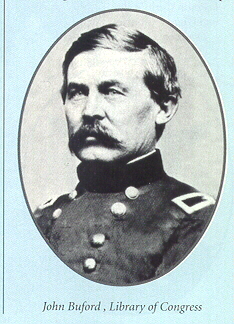
On June 27, 1863, Buford’s Division crossed the Potomac and headed into Maryland. Their assignment was to act as the eyes and ears of the newly formed right wing of the Army of the Potomac, consisting of the 1st, 3rd, and 11th Corps, all under the command of Major General John Reynolds. John Buford had already proved his worth with his solid reconnaissance in the Second Manassas campaign and again in the past few weeks in Virginia. Now he would move forward to find out just where Lee was so that newly appointed head of the army Major General George Meade might bring him to battle. June 30th found Buford with Gamble’s and Colonel Thomas Devin’s Brigades entering the crossroads town of Gettysburg. The scene was described by an 8th Illinois trooper in a letter to the Aurora Beacon.
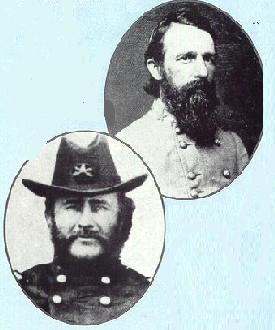
About 7:30 a.m. on July 1, pickets from the 8th Illinois spotted the advance of Heth’s Division down the Chambersburg Pike and fired on the head of the long grey column. Heth, not knowing what was in front of him and with orders to move into Gettysburg but not bring on a fight, immediately sent out a skirmish line from his lead brigade, Brigidier General James Archer’s, to see what was there. Gamble, meanwhile, reinforced his front line with three squadrons, part dismounted, from the troopers back at Seminary Ridge.45 The anonymous Illinois trooper continued in his letter to the Beacon.
Lieutenant Amasa Dana of the 8th Illinois, recalled being forced out of three successive positions as they moved from ridge line to ridge line in their delaying action.
The Confederates, though, were arriving in ever greater
numbers and it was by no means certain that the high ground would be saved
for Meade.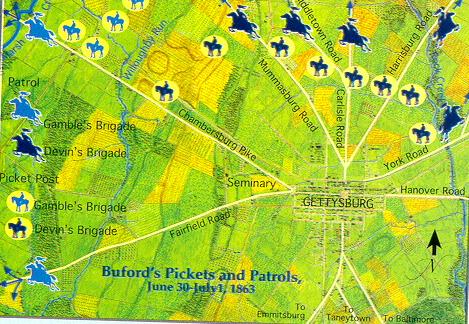 The job
of the 1st and 11th Corps would be to continue to delay Lee north and west
of the town until the rest of the Federal army could come up. Buford’s
cavalry would assist by covering their flanks and further harassing the
Confederates. Since Stuart’s cavalry had not yet returned to Lee’s army,
Buford only had to watch for opportunities to protect a retreat or attack
the enemy infantry’s flank. Gamble was withdrawn eastwards towards Seminary
Ridge where part remained mounted and the rest dismounted and posted with
artillery behind a stone wall. The 8th Illinois was sent further to the
left down the Fairfield Road and posted in an orchard and woodlot. They
didn’t have too long to wait. By mid afternoon, the exhausted 1st Corps
was being pressed back to their last line of defense, a barricade around
the Seminary.
The job
of the 1st and 11th Corps would be to continue to delay Lee north and west
of the town until the rest of the Federal army could come up. Buford’s
cavalry would assist by covering their flanks and further harassing the
Confederates. Since Stuart’s cavalry had not yet returned to Lee’s army,
Buford only had to watch for opportunities to protect a retreat or attack
the enemy infantry’s flank. Gamble was withdrawn eastwards towards Seminary
Ridge where part remained mounted and the rest dismounted and posted with
artillery behind a stone wall. The 8th Illinois was sent further to the
left down the Fairfield Road and posted in an orchard and woodlot. They
didn’t have too long to wait. By mid afternoon, the exhausted 1st Corps
was being pressed back to their last line of defense, a barricade around
the Seminary.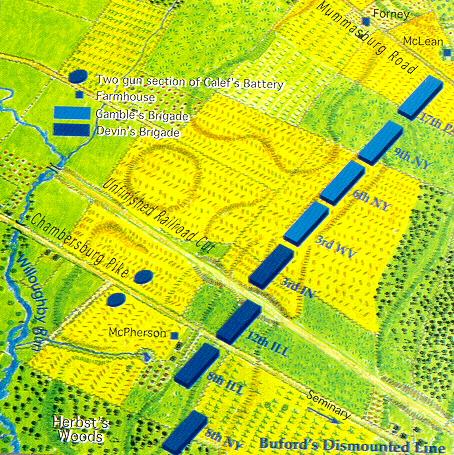 A fresh
Confederate division, under Major General Dorsey Pender, passed through
the lines of Heth’s tired men, and headed across a broad field to attack
the ridge. Gamble’s cavalry immediately began to harrass the Confederate
brigade on the right, Brigidier General James H. Lane’s, completely justifying
Buford’s earlier dispostions. The 8th Illinois rode out of the woodlot
and peppered the exposed flank of Lane’s North Carolinians with carbine
and pistol fire. Lane immediately halted, well short of Seminary Ridge,
and deployed his men, possibly in hollow squares, to defend against a sabre
attack that never came. He never got back into the fight. The center brigade,
Brigidier General Abner Perrin’s South Carolinians, advanced past the halted
Lane, and found themselves enfiladed by the rest of Gamble’s dismounted
force posted behind the stone wall while confronting the well directed
fire of the 1st Corps behind the barricade. Perrin had to change front
to the right to charge, only to see the cavalry mount up and head off to
Cemetery Hill. Buford’s cavalry had helped delay Pender’s attack by a combination
of defensive firepower and the threat of a mounted charge. This gave time
for the 1st Corps and its’ artillery to withdraw in some order.50
The letter to the Beacon continued,
A fresh
Confederate division, under Major General Dorsey Pender, passed through
the lines of Heth’s tired men, and headed across a broad field to attack
the ridge. Gamble’s cavalry immediately began to harrass the Confederate
brigade on the right, Brigidier General James H. Lane’s, completely justifying
Buford’s earlier dispostions. The 8th Illinois rode out of the woodlot
and peppered the exposed flank of Lane’s North Carolinians with carbine
and pistol fire. Lane immediately halted, well short of Seminary Ridge,
and deployed his men, possibly in hollow squares, to defend against a sabre
attack that never came. He never got back into the fight. The center brigade,
Brigidier General Abner Perrin’s South Carolinians, advanced past the halted
Lane, and found themselves enfiladed by the rest of Gamble’s dismounted
force posted behind the stone wall while confronting the well directed
fire of the 1st Corps behind the barricade. Perrin had to change front
to the right to charge, only to see the cavalry mount up and head off to
Cemetery Hill. Buford’s cavalry had helped delay Pender’s attack by a combination
of defensive firepower and the threat of a mounted charge. This gave time
for the 1st Corps and its’ artillery to withdraw in some order.50
The letter to the Beacon continued,
Ultimately, with Lee defeated, Buford would be called upon to take up the pursuit. As Lee withdrew through the South Mountain passes towards the Potomac crossing at Falling Waters, Maryland, Buford’s troopers would again demonstrate both their mounted and dismounted skills.
Thus ended the Gettysburg campaign. In it, Buford had exemplified at least five missions of cavalry - the destruction of enemy cavalry, reconnaisance and screening, the possession of good ground until the infantry could come up, covering the flanks of your army in battle and attacking exposed enemy flanks, and pursuit. Moreover, he demonstrated tactics appropriate to the type of enemy opposed (infantry, cavalry, or artillery) and to the weaponry that he had available. Conventionally, cavalry was not expected to stand against infantry, but the added firepower of the breechloading carbine, enabled an evolution of tactics to where Buford was able to effectively delay a full division of infantry for several hours .
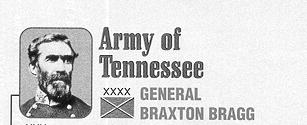

In his history of Minty’s Brigade, Lieutenent Joseph Vale of the 7th Pennsylvania commented that Minty’s troopers had made "five successful saber charges against far superior numbers of infantry...Four successful saber charges against artillery...and over one hundred saber charges against the enemy’s cavalry."52 Many of these occured in the Spring and Summer of 1863. Minty’s men had indeed earned the sobriquet, The Sabre Brigade. These battles demonstrated what a good grasp of dismounted and mounted tactics, a bit of audacity (or as Stanley would say, nerve), and knowing your opponent, could do.
By mid September, Chattanooga had fallen and Rosecrans’
army was gathering around a river called the Chickamauga. On September
16, Minty was camped east of Reed’s Bridge, one of the crossings of that
river, on the extreme left flank of the Union army. In contrast to his
position at Stone’s River, he was now screening the front and flank of
the army, not simply waiting to receive stragglers, clearly a more proper
use of cavalry. Minty’s scouts had found strong signs of Confederate troop
concentration to his east and southeast and reported this to army command,
including 21st Corps commander Major General Thomas L. Crittenden, his
nearest support. Although Minty had actually clashed with Confederate scouting
parties, Crittenden discounted his reports. However, recognizing a four
and one-half mile gap existed between Minty and his infantry units to the
south, the mounted infantry of Colonel John Wilder was ordered on the 17th
to Alexander’s Bridge, some two miles above Minty. Happy that Wilder was
there, but still concerned about indications of Confederate troop movements,
he sent several detachments out to scout about 6 a.m. on the 18th. While
one-hundred troopers from the 4th US went southeast towards Leets, another
one-hundred men from the 4th Michigan and the 7th Pennsylvania went east
up the Ringgold road from Reed’s Bridge. That detachment, crossing another
stream some one and one-half miles to the east, Pea Vine Creek, promptly
ran into an entire division of Confederates under the command of Brigadier
General Bushrod Johnson. This was the vanguard of the Confederate attack
which had been designed to move north of the Union left flank, cross the
Chickamauga, and take Rosecrans in the rear. Unfortunately for Bragg, his
intellegence was old and the Union left flank was further north than he
had expected. Minty was now in a position similar to that which had faced
Buford at Gettysburg. Having met a large force of enemy infantry, he needed
to delay them until his own army could assume adequate defensive positions.
Bragg’s general assault depended on Johnson to begin the attack but, Johnson,
like Heth, was moving without a cavalry screen and, not knowing what was
in front of him, moved very cautiously. What followed was an excellent
use of mounted and dismounted tactics to force the infantry to go on line
and delay their advance for some seven hours. 53
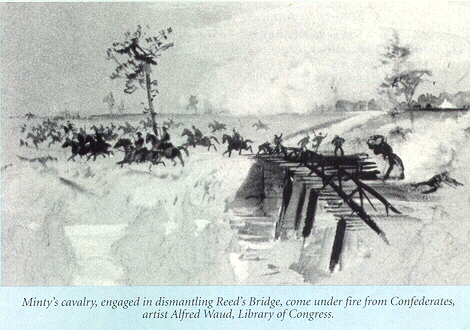
When Captain Heber Thompson of the 7th Pennsylvania
with his detachment of one-hundred troopers discovered Johnson’s force,
they quickly recrossed Pea Vine Creek bridge, dismounted on the west side,
and deployed as skirmishers on the brushy plain inbetween steep Pea Vine
Ridge and the creek. Peppered with unexpected shots, Johnson’s column halted
and threw out skirmishers from the 17th Tennessee who proceeded to exchange
shots with Minty’s men. Confederate reports are not entirely consistant,
but it appears that Johnson stopped to form a battle line, consuming at
least an hour. Forrest had now joined him with his escort and proceeded
to the front with the 44th Tennessee to strengthen the skirmish line. Meanwhile,
Minty had received word at about seven a.m. of the approach of the enemy
and brought forward the 4th Michigan, part of the 4th US, and a section
of the Chicago Board of Trade battery. These he deployed on the eastern
slope of Pea Vine Ridge, overlooking the Rebels. Forrest’s superior numbers
finally began to tell and the Tennesseans crossed the creek, forcing the
Pennsylvanians to retreat up the ridge. Following them, the Confederates
were met with artillery fire and Johnson paused yet another hour calling
for artillery support. While Johnson sorted it out, his one half mile battle
line waited east of Pea Vine Creek. It was now about eleven a.m. and Minty,
on Pea Vine Ridge, observed a column of dust moving towards Dyer’s Bridge
and ford lying uncovered a mile to the north. Concerned that Johnson might
be flanking him, he called upon Wilder to send some troops to cover it.
Wilder obliged and Colonel Abram Miller soon arrived with two regiments
and two mountain howitzers which were sent on to Dyers’. 54
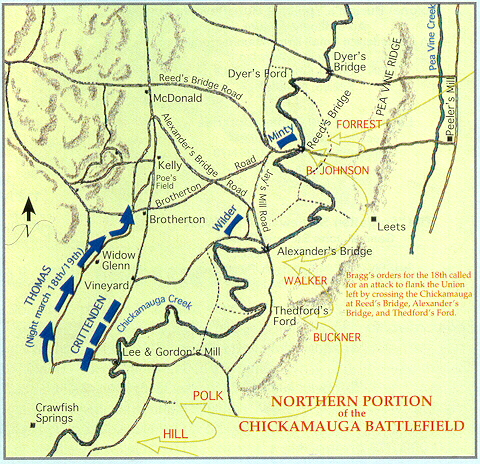
Johnson, receiving a message from Bragg that he
was holding up the entire attack, had his recently arrived artillery fire
a few shots and once again sent forth his skirmishers. Minty retired his
line over the top of the ridge, reforming it astride the road just four
hundred yards east of Reed’s Bridge. At the same time, he masked two sections
of the Chicago battery and one battalion of the Regulars near the bridge.
When the Confederate skirmishers finally reached the top of the ridge,
they realized their four infantry brigades had been delayed four hours
by a relative handful of cavalrymen (Minty had a total of 973 horsemen).
Johnson now pushed his men along the road through the gap in Pea Vine Ridge.
However, it was a narrow defile and only a column of troops could pass.
Minty had the artillery open up on the head of the column "and before they
could recover or deploy, the Seventh Pennsylvania and Fourth Michigan delivered
a terrific sabre charge, riding through their thronging masses and drove
that column back through the gap and up to the top of the ridge." Furious,
Johnson now called for a general advance, which was fine with Minty as
it took quite a while to deploy. Johnson’s battle line was delayed in crossing
"the deep and muddy stream" (Pea Vine Creek) and, as Lieutenant Colonel
Snowden of the 25th Tennessee reported, "the difficulty now was to march
in line of battle over the very rough and uneven ground, passing briar-thickets,
many of the men being barefooted." 55 Naturally,
Minty had no way of stopping 7000 men and was quickly pushed back and outflanked.
He withdrew towards Reed’s Bridge, the Confederates double quicking after
him, carrying their arms at the right shoulder shift. As the first ones
approached the crossing, the masked sections of the Chicago Board of Trade
Battery opened on them supported by the battalion of Regulars.
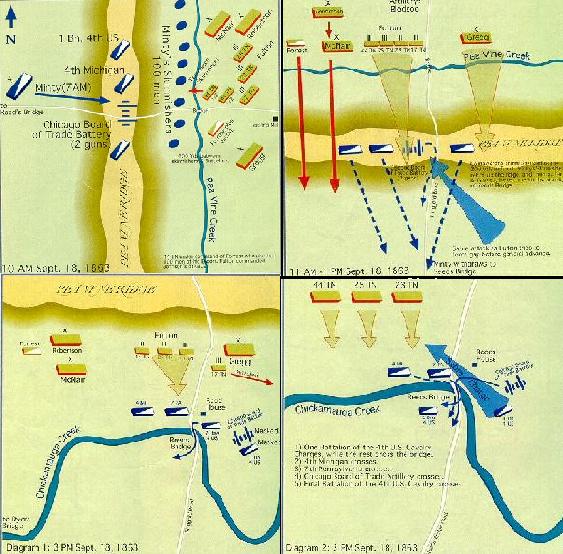
Johnson again halted to deploy, which allowed most of Minty’s force to cross Reed’s Bridge, but the Tennesseeans of Johnson’s Brigade, without orders, again moved forward with a shout capturing Reed’s bridge. "The squadron of the Fourth Regulars...which had been supporting the artillery, being in great danger of capture before the Seventh could clear the bridge, wheeled and, by a most daring and desperate sabre charge, cleared sufficient space and gained sufficient time to cover the crossing of the Seventh and make good their own retreat." One squadron of the 4th Michigan was cut off and had to swim the Chickamauga to escape. Johnson’s lead brigade finally began to cross the Chickamauga at three p.m. and even then, Minty opened up with artillery to force further delay upon him. When Johnson was finally on the West side of the Chickamauga (Johnson says four p.m. while Minty says five p.m.), and formed to attack, Minty was gone. By this means, Bragg’s whole attack on the left wing was disarranged.56 The main attack on the Federal lines would take place on the 19th, a day later and with far more warning than Bragg had intended. Like Buford on July 1 at Gettysburg, Minty was fortunate to run into an over cautious Confederate General, but in both cases, the point was proved that the cavalry, using defensive firepower and mounted charges, could be effective to delay infantry. Instead of saddling up and leaving when infantry was detected, the cavalry could now expect to be an integral part of the striking force of the whole army.
The year and a half from January 1863 to the Summer of 1864 saw the Federal cavalry become competant dragoons. They were now able and skilled veterans that were as comfortable making a mounted sabre and pistol charge as standing behind a stone wall breaking the charge of enemy infantry or cavalry. The mission of cavalry as supports to the infantry and artillery were now fairly clear as was the type of troops needed - dragoons armed with breech loading carbines (preferably multiple shot Spencers), 6 shot pistols, and sabres. The final culmination for the Federal cavalry would be the evolution of its mission to include massed mounted raids as independent commands, an evolution that had already commenced with the mounted raids of 1864. What was needed now were competant commanders who could lead such autonomous commands, leaders who would no longer just be staff officers to the commanding General.
The role of heavy cavalry in European armies was to be a strike force that could play a significant role in battle. Light cavalry performed the other functions of scouting, screening, pursuit, and so on, serving as adjuncts and supports to the infantry and artillery. More effective firearms had slowly reduced heavy cavalry’s role until only light cavalry was left to play its role as an aid to the main strike force. The American Civil War, however, revitalized the role of cavalry. It did not recreate the heavy cavalry, who could not have operated in the wooded terrain of North America, but instead, by improving the firepower of the cavalry and making the trooper an effective dragoon, paved the way for the Federal cavalry to again assume the role of a strike force. What this in fact involved was the creation of cavalry armies, masses of cavalry operating in either close coordination with the infantry, as in the Valley, or in independent commands, as in Wilson’s Selma raid. The mounted raids of 1863 and 4 were a beginning in that direction, but were limited in scope and objective. The cavalry army tended to exercise more autonomy and act more like an infantry command, being given basic orders and objectives leaving the commanders themselves to devise the best way to carry them out. Wilson exemplifies this very well. Significantly, too, while there was no intent for these cavalry armies to confront large masses of enemy infantry, their mission did not dictate that they shy away from such forces. Neither Sheridan nor Wilson hesitated to attack any enemy forces in their front, regardless of type, given the right circumstance. The expectation was that the new cavalryman/dragoon could handle any opposition within reason.
Wilson, recently with Sheridan in the Shenandoah Valley, had come West in October 1864 to command the cavalry corps that Sherman had left behind. His distinct idea was that cavalry ought to be used as a strike force. "Cavalry is useless for defense; its only power is in a vigorous offensive; therefore I urge its concentration south of the Tennessee and hurling it into the bowels of the South in masses that the enemy cannot drive back."57 He appreciated the sabre but felt that the Spencer repeating carbine was also necessary to the cavalryman’s success. "...The true plan of action was a heavy dismounted skirmish line corresponding to the infantry line of battle, with a mounted force to charge the enemy’s flanks and cut in upon his rear as opportunity offered."58 This in fact was how cavalry tactics had been developing as shown by many actions of Minty’s Brigade. As General John Bell Hood’s army moved towards Tennessee and eventual destruction, Wilson began to call all the scattered details of the cavalry back together again. Now in early 1865, with Hood’s army no longer a factor, the only significant mobile force left in the middle South was Forrest with some 10,000 men of all arms - some of them mounted infantry from the remnants of Hood’s army. When Grant wanted a diversion in central Alabama for the attack on Mobile, Wilson saw his chance and argued for a real invasion to show how his cavalry might be used as a strike force. Grant and Thomas agreed.59 Wilson drove South and on April 2, overwhelmed Selma and its defenders. Wilson’s raid brought the Federal cavalry to its highest development in the Civil War. It had now added the mission of autonomous ‘strike force’ to its repetoire. Writing to Grant a month after the war ended, Wilson commented that,
Over the four years of the American Civil War, the Federal Cavalryman developed from rank beginner to effective dragoon. The cavalry, at the same time, developed a strong sense of mission which involved not only the conventional light cavalry tasks of screening, pursuit, reconnaissance, and so on, but revived some of the sense of the hitting force of the heavy cavalry. More than just a question of acquiring skills, this was an evolution beyond the European tradition. The men gained tactical skill, mounted and dismounted, through the practical experience of doing their duty. By the time they became efficient dragoons, their mission became more defined and they had the tools to accomplish it. By then, the veterans understood the type of enemy they were dealing with, had learned basic skills with sabres and carbines, and had a good idea of which to use and when. At the same time, their generals realized that if they were going to be of any use, they would have to take the cavalry away from the infantry commanders and allow them to operate as units. The benefits of this wise policy immediately showed themselves as the Union cavalry not only began to better accomplish their tasks, but to hold sway over their Confederate opponents.
The evolution of the Federal cavalry, however, did not stop there. At Gettysburg and Chickamauga they saw that they could hold regular infantry at bay and delay it, implying a mission of seizing and holding ground for the infantry. The development of dismounted fighting and the availability of greater firepower gave it an ability that European theory did not envision for light cavalry, or even dragoons. Not only could it delay infantry, but in the Shenandoah, at Nashville, and at Selma, it showed that it could attack infantry forces and be successful. Finally, having proved that it had striking capability, Wilson proved that an additional mission of the cavalry could be the independent strike force, a whole new mobile army that could materially aid the cause of the main armies fighting miles away. It was not an army of mounted infantrymen, however, but of dragoons who still relied on the sabre charge in the proper situation and who fought in cavalry, not infantry, formations. It is significant that the last action of Minty’s Brigade involved capturing a Flint River bridge in Georgia with a sabre charge, after Lee’s surrender.
In 1865, this was probably the most formidable dragoon
force in the World. But the volunteer cavalry would soon be discharged
and the war in the West would not be appropriate for sabre charges or mass
invasions. By the time the United States was involved in another major
war, the era of cavalry had passed and the horse replaced by motorized
and airborn vehicles. There would not again be a need for masses of cavalry
thrown against the territory of the enemy.
Laurence A. Schiller is a lecturer in history and head fencing coach at Northwestern University, Evanston, Illinois. This is his first published article on the Civil War. His monograph Of Sabres and Carbines: The Evolution of Federal Cavalry Tactics is to be published by the Blue and Gray Education Society, Danville, Virginia, in 1999.
Thanks to Earl McElesh for the use of his Gettysburg maps
as a background for the Buford maps in this article. The MacElresh
Map Company can be contacted at P.O. Box 565, Olean, NY 14760.